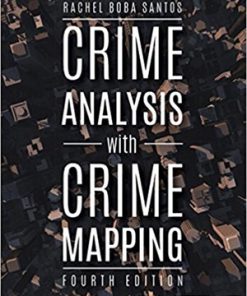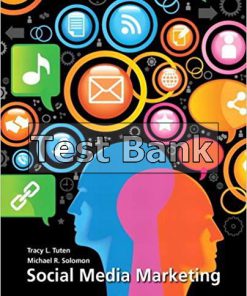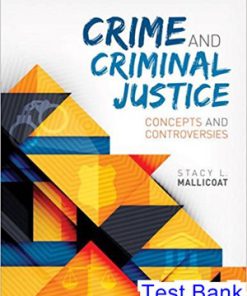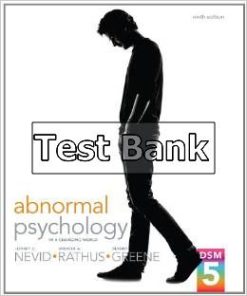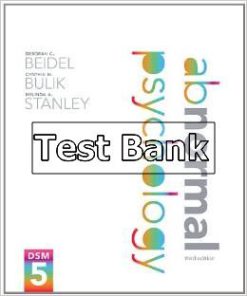Media and Crime in the U S 1st Edition Jewkes Test Bank
You may also like
Media and Crime in the U S 1st Edition Jewkes Test Bank

Product details:
- ISBN-10 : 1483373908
- ISBN-13 : 978-1483373904
- Author: Yvonne Jewkes
The rise of mobile and social media means that everyday crime news is now more immediate, more visual, and more democratically produced than ever. Offering new and innovative ways of understanding the relationship between media and crime, Media and Crime in the U.S. critically examines the influence of media coverage of crimes on culture and identity in the United States and across the globe. With comprehensive coverage of the theories, research, and key issues, acclaimed author Yvonne Jewkes and award-winning professor Travis Linnemann have come together to shed light on some of the most troubling questions surrounding media and crime today.
Table contents:
- Chapter 1 Theorizing Media and Crime
- • Overview
- • Key Terms
- Media “Effects”
- Mass Society Theory
- Behaviorism and Positivism
- The Legacy of Effects Research
- Strain Theory and Anomie
- Marxism, Critical Criminology, and the “Dominant Ideology” Approach
- The Legacy of Marxism: Critical Criminology and Corporate Crime
- Pluralism, Competition, and Ideological Struggle
- Realism and Reception Analysis
- Late Modernity and Postmodernism
- Cultural Criminology
- • Summary
- • Study Questions
- • Further Reading
- Chapter 2 The Construction of Crime News
- • Overview
- • Key Terms
- News Values for a New Millennium
- Threshold
- Predictability
- Simplification
- Individualism
- Risk
- Sex
- Celebrity or High-Status Persons
- Proximity
- Violence or Conflict
- Visual Spectacle and Graphic Imagery
- Children
- Conservative Ideology and Political Diversion
- Two Examples of Newsworthy Stories Par Excellence
- The Murder of the Clutter Family and Truman Capote’s In Cold Blood
- Anders Behring Breivik and the Spree Killing of 77 People in Norway
- News Production and Consumption in a Digital Global Marketplace: The Rise of the Citizen Journalist
- News Values and Crime News Production: Some Concluding Thoughts
- • Summary
- • Study Questions
- • Further Reading
- Chapter 3 Media and Moral Panics
- • Overview
- • Key Terms
- The Background of the Moral Panic Model
- How the Mass Media Turn the Ordinary Into the Extraordinary
- The Role of the Authorities in the Deviancy Amplification Process
- Defining Moral Boundaries and Creating Consensus
- Rapid Social Change—Risk
- Youth
- Problems With the Moral Panic Model
- A Problem With “Deviance”
- A Problem With “Morality”
- Problems With “Youth” and “Style”
- A Problem With “Risk”
- A Problem of “Source”
- A Problem With “Audience”
- The Longevity and Legacy of the Moral Panic Model: Some Concluding Thoughts
- • Summary
- • Study Questions
- • Further Reading
- Chapter 4 Media Constructions of Children: “Evil Monsters” and “Tragic Victims”
- • Overview
- • Key Terms
- Children as “Evil Monsters”
- Children as “Tragic Victims”
- Guilt, Collusion, and Voyeurism
- Moral Panics and the Revival of “Community”: Some Concluding Thoughts
- • Summary
- • Study Questions
- • Further Reading
- Chapter 5 Media Misogyny: Monstrous Women
- • Overview
- • Key Terms
- Psychoanalytic Perspectives
- Feminist Perspectives
- Sexuality and Sexual Deviance
- Physical Attractiveness
- Bad Wives
- Bad Mothers
- Mythical Monsters
- Mad Cows
- Evil Manipulators
- Non-agents
- Honorable Fathers Versus Monstrous Mothers: Some Concluding Thoughts
- • Summary
- • Study Questions
- • Further Reading
- Chapter 6 The Police Image and Policing the Image
- • Overview
- • Key Terms
- The Mass Media and Fear of Crime
- The Police Image: Television and Film
- Cops and Reality TV
- Policing and Social Media
- Image Management
- • Summary
- • Study Questions
- • Further Reading
- Chapter 7 Crime Movies and Prison Films
- • Overview
- • Key Terms
- The Appeal of Crime Movies
- The Crime Movie: Masculinity, Autonomy, the City
- The “Prison Film”
- The Prison Film and the Power to Reform?
- The Documentary
- Documentary as Ethnography
- The Remake
- The Taking of Pelham One Two Three and The Taking of Pelham 123
- Discussion
- Concluding Thoughts
- • Summary
- • Study Questions
- • Further Reading
- Chapter 8 Crime and the Surveillance Culture
- • Overview
- • Key Terms
- The NSA and a New Age of Surveillance
- Panopticism
- The Surveillant Assemblage
- Control of the Body
- Governance and Governmentality
- Security and “Cybersurveillance”
- Profit
- Voyeurism and Entertainment
- From the Panopticon to Surveillant Assemblage and Back Again
- “Big Brother” or “Brave New World”? Some Concluding Thoughts
- • Summary
- • Study Questions
- • Further Reading
- Chapter 9 The Role of the Internet in Crime and Deviance
- • Overview
- • Key Terms
- Redefining Deviance and Democratization: Developing Nations and the Case of China
- Cyberwarfare and Cyberterrorism
- “Ordinary” Cybercrimes
- Electronic Theft and Abuse of Intellectual Property Rights
- Hate Crime
- Invasion of Privacy, Defamation, and Identity Theft
- eBay Fraud
- Hacking and Loss of Sensitive Data
- Child Pornography and Online Grooming
- Childhood, Cyberspace, and Social Retreat
- Concluding Thoughts
- • Summary
- • Study Questions
- • Further Reading
- Chapter 10 (Re)Conceptualizing the Relationship Between Media and Crime
- • Overview
- • Key Terms
- Doing Media-Crime Research
- The Importance of the Visual
- Taking Media-Crime Research Seriously
- Stigmatization, Sentimentalization, and Sanctification: The “Othering” of Victims and Offenders
- • Summary
- • Study Questions
- • Further Reading
- Glossary
- References
- Index
- About the Authors
People also search:
media and crime in the u.s
media and crime in the us jewkes pdf
media and crime in the u.s. jewkes pdf free
history of the media in the united states
social media and the 1st amendment

